What is DTF PET Film? [Full Explained Guide 2025]
Ever wondered how those eye-catching, full-color designs appear on t-shirts, hats, and even phone cases? Direct-to-film (DTF) printing is a culprit, and behind the scenes is an unsung hero: DTF PET film.
The advantages of DTF printing are so obvious that it has become a popular technique to create vibrant and long-lasting designs on all sorts of fabrics. But just like any other printing method, the quality of your final product depends on using the right materials. And when it comes to DTF film, it should be your top-tier.
This blog dives deep into the DTF PET film, explaining what it is, its properties, its types, and how it works its magic. I’ll also break advantages of using it and how to choose the right DTF film for your printing project.
Whether you’re a seasoned pro or just starting out, this guide will help you avoid printing headaches and give out stunning results every time.
Table of Contents
What is a DTF PET Film?
DTF PET film is also known as DTF transfer film. It is a specially formulated plastic film made from polyethylene terephthalate (PET). Due to its suitability for many different materials like cotton, nylon, polyester, leather, and light and dark-colored fabrics, it’s very popular in printing lines.
Unlike regular PET film, it’s designed for the DTF printing process. DTF film boasts unique coatings that make it the perfect medium for transferring intricate designs onto various substrates, most commonly textiles like t-shirts.
Structure of DTF PET Film
To better understand the DTF film, go deep dive into its structure. This specialized film is a sturdy and reliable medium to transfer full-color designs onto various substrates. Let’s take a closer look at the anatomy of DTF PET Film.
- PET (Polyethylene Terephthalate) Substrate
The backbone of DTF PET film is Polyethylene Terephthalate, a versatile and very commonly used thermoplastic polymer. This layer is where the special adhesive is coated onto the PET material.
PET is a material that scores very well in physical parameters like impact strength, transparency, chemical stability, etc. It gives a substrate for printing projects that will remain active or maintained even when exposed to different, more volatile elements.
- Adhesive Layer
This adhesive layer has its unique importance in DTF film. It serves as a binding agent and binds the design on the film to the final substrate which will receive the transferred design.
It is a barrier that allows for the easy transition of the film from the heat press to the substrate upon heating. It provides an adhesion to the surface that is strong enough, so the design will not come off or fade over time.
When exposed to the heat during the heat press process, the paint becomes activated and bonds with the substrate producing a durable, long-wearing transfer.
- Printing Layer
On top of the adhesive layer is the printing surface, where the actual magic happens. The printing surface holds the richness of the printing ink and holds it in place until it is ready for transfer.
The DTF film can be printed with different types of printing inks including eco-solvent and UV-curable inks. Such flexibility allows the user to print on the equipment that they fancy most and get their customized results.
- Base Layer
The base layer of DTF Film provides the foundation for the printing process. Commonly used base films are paper bases and PET films. The paper is relatively soft and easily contoured while cutting.
At present, commonly used are PET films, whose plus point of high tensile strength and no deformation make it replaceable to a paper base. That base layer serves several crucial functions, such as ink receptivity and heat transfer during the curing process.
- Release Layer
Finally, the DTF PET Film is typically supplied with a release liner. This liner is a protective layer that covers the adhesive side of the film, keeping it clean and free from contaminants until it’s ready for use.
Its main purpose is to separate the printing film from the base layer. The release liner also facilitates the peeling process when transferring the printed design to the substrate.
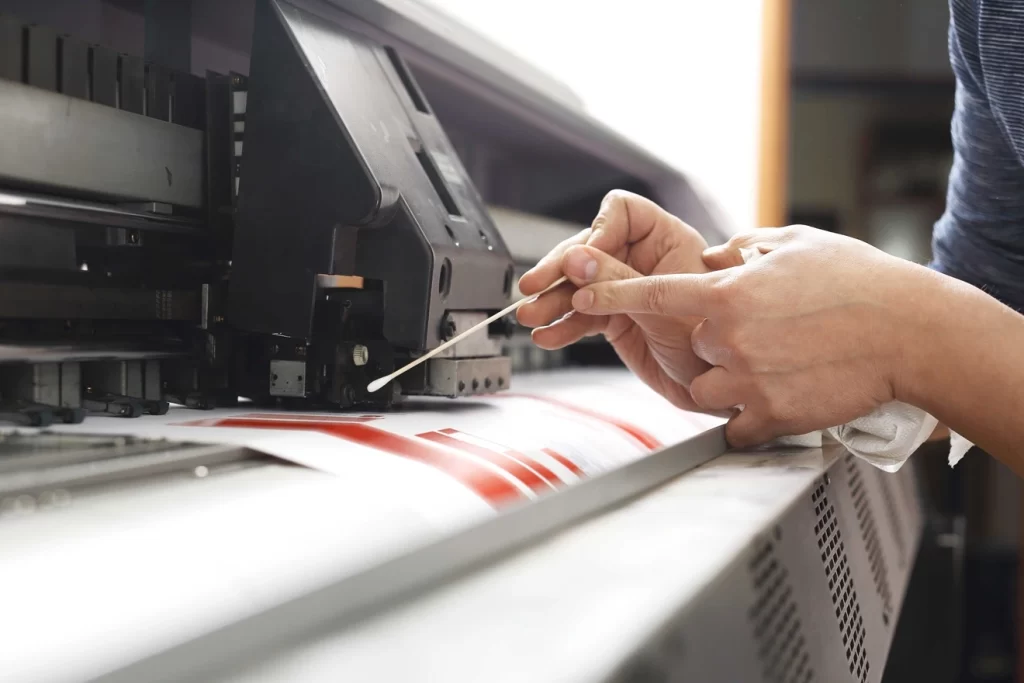
Properties of DTF PET Film
- Ink Absorption: DTF film has a specially coated surface that readily absorbs DTF inks. It allows excellent ink adhesion and vibrant color reproduction.
- Release Liner: The backside of the film features a release liner that allows for easy and clean removal of the film after the adhesive powder is applied.
- Heat Resistance: DTF film is formulated to withstand the high temperatures used during the heat pressing process, ensuring proper ink transfer without burning or melting.
- Dimensional Stability: DTF film maintains its shape during the printing and pressing stages, resulting in a crisp and accurate transfer of the design.
- Available Variations: DTF film comes in different finishes (matte or glossy) and peel types (hot peel or cold peel), offering flexibility for various applications.
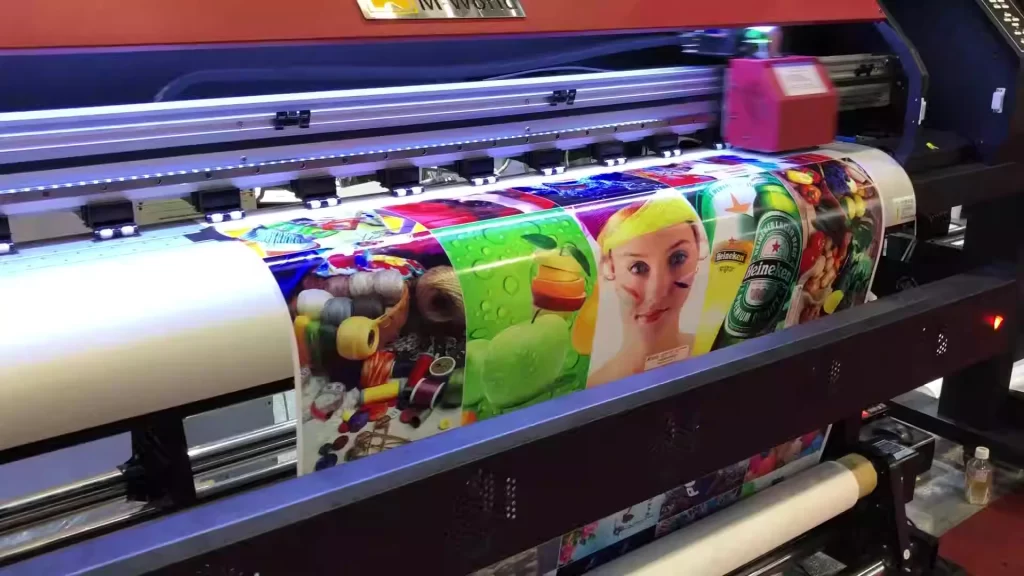
Types of DTF PET Films
Before knowing how DTF PET film works in the printing business, getting an idea about the different types of DTF film is the first thing to know.
There is no doubt that the most common types of DTF film are hot peel and cold peel film, but more types are also classified from different perspectives.
By Coating Perspective
From a coating perspective, DTF film is classified into single-side and double-side coating films.
At the start of DTF printing, the single-side coating film was popular. However, in those days the machines were not so advanced and problems of sliding dislocation were used to occur. It takes time to tear off the film after pressing.
As we live in a golden age of innovation and technology, double-sided coating film(coating in the back) is now in our hands. These films are designed to prevent sliding. It could be turned off in seconds and yield shiny effects after transfer.
By Release Perspective
For the release process, DTF film is classified into hot peel film and cold peel film. You can’t peel off the cold peel film until the film cools down after the heat press. Due to its sticky nature, the hot peel film could be easily peeled off soon after the heat press.
By Visual Perspective
According to visual effects, DTF film is classified into reflective colorful film, matt DTF, glossy DTF, laser film, luminous film, low-temperature DTF film, and shining film.
Reflective colorful films are so catchy as they reflect light to leave a unique visual impact and make your design more stunning. Laser film exhibits lasers under light. In the dark environment, images printed with the luminous film will sparkle and show green light.
Low-temperature DTF PET film is designed to work with DTF printers for small businesses and heat presses that operate at lower temperatures. This type of film is used for printing on heat-sensitive fabrics without the risk of damage.
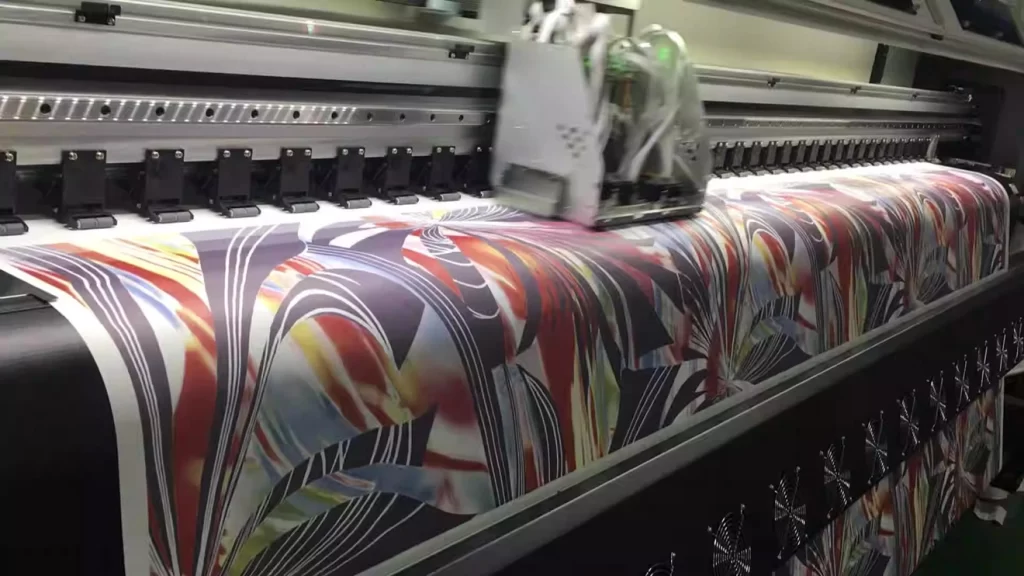
How does DTF PET Film Work?
DTF printing uses DTF PET film as an intermediary carrier for the design. Here’s a simplified breakdown of the process:
- Printing on the Film: The desired design is printed directly onto the ink absorption layer of the DTF film using a DTF printer with special inks.
- Powder Power: After printing design, the film is dusted with a special adhesive powder also known as DTF powder that adheres to the ink.
- Curing: Once the design is printed, it needs to cure. It involves using a heat press to apply heat and pressure to the film. This activates the adhesive powder, fusing the design onto the fabric.
- Transfer the Design: Now comes the exciting part. You peel the printed design from the PET film, revealing a flexible, durable transfer. This transfer is then ready to be applied to the final substrate, whether it’s a t-shirt, bag, or any other fabric.
Advantages of Using DTF Film
So, why choose DTF film over other printing methods? Here are some compelling reasons:
- Vibrant Colors: DTF film gives out vivid, high-quality prints with excellent color saturation. Your designs will pop off the fabric, attracting attention and admiration.
- Easy to Use: The process of using DTF films is super easy. That’s why it’s so popular in the heat transfer printing method. The process is all about directly printing ink on the film, sprinkling powder, and heat pressing the film to print the design on the substrate without the need for any waste discharge.
- Durability: The final prints by DTF film are durable and long-lasting as compared to DTG (Direct-to-garment) printing. These prints can withstand numerous washes without fading or cracking, making them ideal for garments and products that undergo frequent use.
- Versatility: DTF film works on a wide range of materials, including various fabrics (cotton, polyester, blends) in light or dark colors. You can even use it on some non-fabric items like phone cases or mugs if they can handle the heat-pressing process.
- Faster Production: Compared to pretreated shirts for DTG printing, there’s no such step with STF printing. It saves time and money for the tight-budget business. And like screen printing, there’s no need to set up a screen.
- Environmental Friendly: PET films are eco-friendly as they can be recycled and reused. The ink used in DTF film is free from harmful chemicals, resulting in lower chemical water and emission.
Application of DTF PET Film
The beauty of DTF film lies in its versatility. Here are just a few of the many applications:
- T-shirts, hoodies, hats and socks
- Promotional items such as bags, totes, flags, banners, and even phone cases
- Sportswear like jerseys, workout gear, and sports accessories
- Pillows, blankets, curtains, backpacks, language
What is the Recommended Thickness of DTF PET Film?
The recommended thickness of DTF film varies depending on the specific application and printing requirements. However, common thickness ranges for films are typically between 75 microns (0.075 mm) to 150 microns (0.15 mm).
Here is a general guideline for the recommended thickness of DTF film based on different applications:
- Apparel Printing- For standard t-shirt printing and fabric applications, a thickness of 75 microns (0.075 mm) is recommended for thin fabrics and 100 microns (0.1 mm) for rougher fabrics.
- Promotional Products: For items such as bags, totes, hats, and other accessories, a thickness of 100 microns (0.1 mm) to 125 microns (0.125 mm) is commonly used.
- Sportswear: For activewear, sportswear, and garments that require flexibility and stretchability, a PET film of 125 microns (0.125 mm) to 150 microns (0.15 mm) is used.
For specific applications where enhanced durability or unique effects are desired, thicknesses outside of these ranges may be used.
High-stretch films for stretch fabrics, high-tack films for textured surfaces, or matte films for a subdued finish might have varying thickness recommendations.
Tips to Get the Best Results With DTF Film
No doubt, choosing the right DTF film enhances the printing quality of DTF transfers. To ensure the best results and maximize the potential of DTF film, consider these helpful tips:
- Choose the right DTF printer for your needs (including printer size, number of print heads, and resolution). Also, ensure the cost and availability of ink for the printer.
- Select the appropriate type of DTF PET film based on your printing application. Consider factors such as fabric type, color, texture, and desired finish (clear, white, glossy, matte, etc.).
- Properly calibrate your printer for DTF film to achieve accurate colors and precise printing. Follow the manufacturer’s guidelines for ink settings, print head alignment, and heat settings.
- Ensure you are using DTF-compatible inks designed for use with PET films. Pigment inks are best as they have excellent washability and produce long-lasting prints. While low-quality inks fade colors and cause smudging.
- When transferring the printed design to the substrate, allow the film to cool slightly before peeling to avoid smudging or distortion. Peel the film carefully and evenly to ensure the entire design transfers smoothly onto the substrate.
- Store DTF transfers in a clean, dry environment away from direct sunlight and moisture to maintain its integrity. Handle the film with clean hands or gloves to prevent fingerprints or contaminants that could affect print quality.
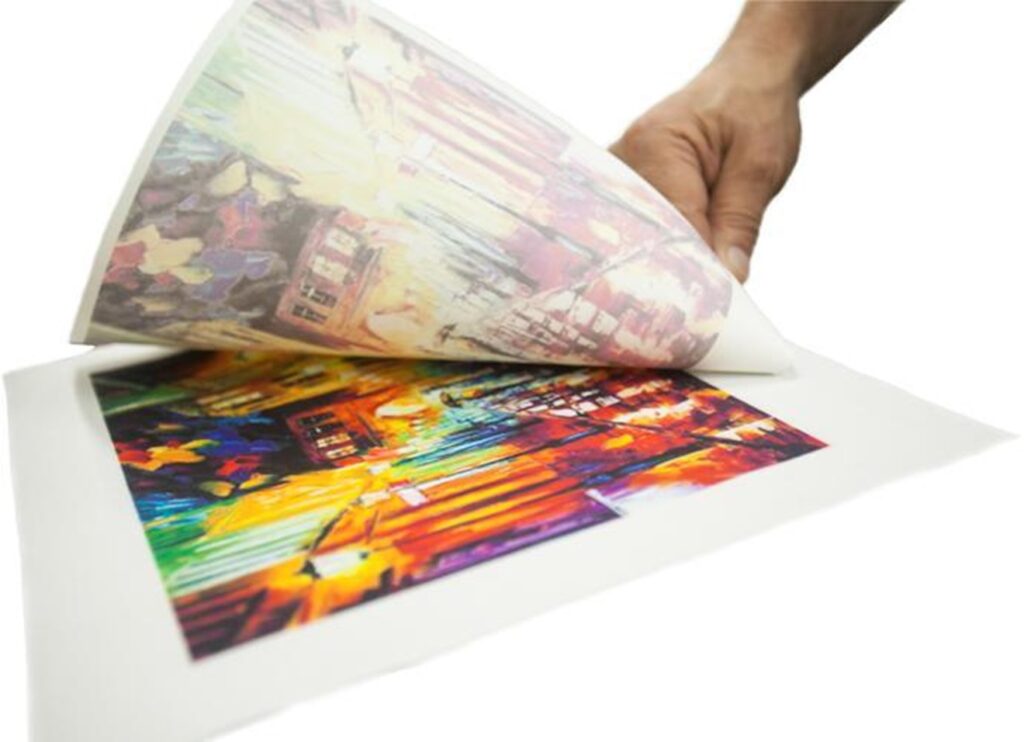
Choosing the Right DTF PET Film
With various DTF films available, choosing the right one can be overwhelming. Here are some factors to consider:
Ink Absorption Capacity- A top-notch DTF film should absorb ink at the right time. I trust the ink dries up within 30 to 60 seconds as hits the film. Poor ink-absorption capacity may cause white and color ink to mix or bleed on the films. So it is important to select a film with a high ink-absorption coating.
Consider Print Compatibility- Ensure film compatibility with your printing equipment, including printers, inks, and heat presses. Choose a film that is specifically designed for use with your printer and ink type to achieve optimal print quality and adhesion.
Film Thickness- While film thickness depends on the application it affects the drape and feel of the final product. Proper handling and ink adsorption depends on the microns of your DTF film. Consider to balance between durability (thicker films) and printability/transfer efficiency (thinner films).
Peel Type- Hot peel offers a more durable bond and better wash fastness, while cold peel is faster and easier to handle. Consider the surface you’ll be transferring the design to. Some films are better suited for specific materials.
High Temperature Resistant- Now, let’s talk about the curing of DTF film. A high temperature of 120-140°C is required to hot melt powder to print a transfer beautifully. Make sure the film withstands high temperatures and does not become yellow or wrinkled during the process.
Why is DTF PET Films Popular in the Thermal Transfer Market?
With the advent of digital printing machines, the fashion industry has come on an easy track. From carving to cutting printed patterns, it’s handy to do with a printer.
The DTF PET film is directly meant to print ink onto the film and then sprinkle powder to set the heat transfer. The process is as simple as pie for novices in the thermal printing industry.
The investment threshold is also very low; a big reason behind its popularity among businesses with tight budgets. It’s easy for printing enthusiasts in the market, whether it’s an individual business or team work.
Another compelling reason is its good flexibility that reduce the ultimate stock costs. In the past, when selling T-shirts in the market, it was always needed to print the final product in advance and make a good stock.
While today, with help of DTF PET Film method, it is only necessary to store thermal transfer film depending on the market conditions. When customers place an order, it is processed and converted into T-shirts that greatly reduce stock costs, increasing the capital turnover and use efficiency.
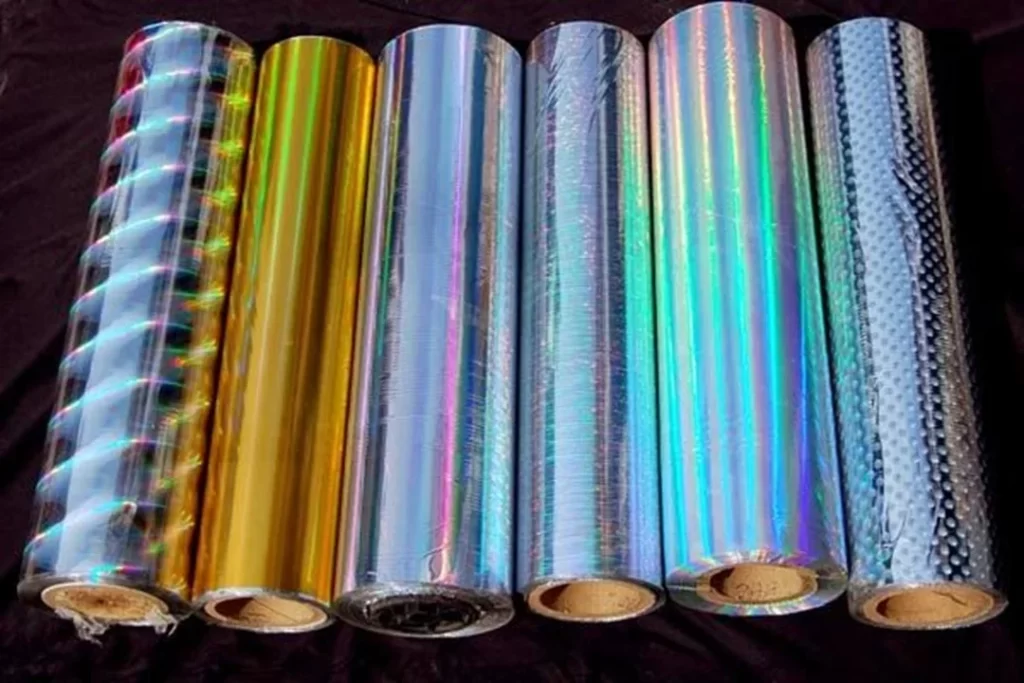
Conclusion
DTF PET film is a vital component in the DTF printing process. By understanding its role in the printing process, you can appreciate the technology behind those eye-catching t-shirt designs.
For DTF printing enthusiasts, choosing the right film is the answer you’ve been searching for( Question: how can I get vibrant prints with DTF printing?). You can achieve stunning and long-lasting results for your t-shirt designs and other garment decoration projects.
That’s all for now, folks! Stay tuned with theprinterexpert.com for more tips, and trends in the dynamic DTF printing world!
